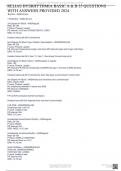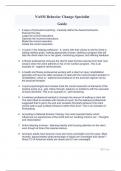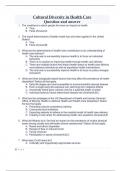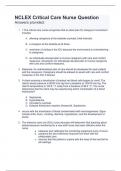KNOLWEDGE STORE
We provide with the best suitable and convenient documents in exams ,class notes and summary well designed, precise and deeply enriched with the best knowledge on a given field.
- 16
- 0
- 0
Community
- Followers
- Following
16 items

RELIAS DYSRHYTHMIA BASIC A & B 35 QUESTIONS WITH ANSWERS PROVIDED 2024
Big Box - ANS0.20 sec 1 Small Box - ANS0.04 sec 1st Degree AV Block - ANSRegular Rate: 60-100 P Wave: Present, upright PR interval: >0.20 sec CONSISTENTLY LONG QRS: <0.12 sec Husband stays late till 9 consistently 2nd Degree AV Block Type I Mobitz, Wenckebach - ANSIRREGULAR Rate: 60-100 P wave: Present, upright PR Interval: Progressively longer until drop (PR interval longer and longer until drop) QRS: <0.12 sec Husband stays late till 9, then 11, then 1, then do...
- Exam (elaborations)
- • 120 pages •
Big Box - ANS0.20 sec 1 Small Box - ANS0.04 sec 1st Degree AV Block - ANSRegular Rate: 60-100 P Wave: Present, upright PR interval: >0.20 sec CONSISTENTLY LONG QRS: <0.12 sec Husband stays late till 9 consistently 2nd Degree AV Block Type I Mobitz, Wenckebach - ANSIRREGULAR Rate: 60-100 P wave: Present, upright PR Interval: Progressively longer until drop (PR interval longer and longer until drop) QRS: <0.12 sec Husband stays late till 9, then 11, then 1, then do...

RELIAS DYSRHYTHMIA BASIC A & B 35 QUESTIONS WITH ANSWERS LATEST MARCH 2024
2nd Degree Heart Block (Mobitz II) - ansRare, but more serious Sudden appearance of a nonconducted P-wave P-waves are nl, but some aren't followed by a QRS complex PR & RR intervals are constant 2nd degree heart block type 1 (Wenkebach) - ansProgressively longer PR interval until the P wave is not followed by a QPR 3rd degree heart block - ansno obvious correlation between p and qrs, need pace maker Accelerated Idioventricular Rhythm - ansRate: 50 - 100 usually (usually slow) P wa...
- Exam (elaborations)
- • 3 pages •
2nd Degree Heart Block (Mobitz II) - ansRare, but more serious Sudden appearance of a nonconducted P-wave P-waves are nl, but some aren't followed by a QRS complex PR & RR intervals are constant 2nd degree heart block type 1 (Wenkebach) - ansProgressively longer PR interval until the P wave is not followed by a QPR 3rd degree heart block - ansno obvious correlation between p and qrs, need pace maker Accelerated Idioventricular Rhythm - ansRate: 50 - 100 usually (usually slow) P wa...

NASM Behavior Change Specialist summary form
NASM Behavior Change Specialist Guide 1. 6 steps of behavioral coaching - Carefully define the desired behaviors. Execute the play. Judge the correct executions. Describe the incorrect executions. Model the correct execution. Imitate the correct execution. 1. A coach in the helping profession - b. works with their clients to aid the client in setting realistic goals, making appropriate choices, defining a program that will help the client reach his or her goals, monitoring progress, an...
- Summary
- • 6 pages •
NASM Behavior Change Specialist Guide 1. 6 steps of behavioral coaching - Carefully define the desired behaviors. Execute the play. Judge the correct executions. Describe the incorrect executions. Model the correct execution. Imitate the correct execution. 1. A coach in the helping profession - b. works with their clients to aid the client in setting realistic goals, making appropriate choices, defining a program that will help the client reach his or her goals, monitoring progress, an...

Exam (elaborations) NETWORKING DESIGN AND DESIGN
a) Differentiate between IPV4 and IPV6 addressing systems. (2 Marks) b) Explain Four benefits of an active directory system. (4 Marks) c) In today’s world, networks are very important component for any successful business to consider. However, it’s no longer practical to construct networks by connecting many standalone components without careful planning and design. Describe four factors that a network designer must consider before putting up a network. (8 Marks) d) Vulnerability is a ...
- Exam (elaborations)
- • 2 pages •
a) Differentiate between IPV4 and IPV6 addressing systems. (2 Marks) b) Explain Four benefits of an active directory system. (4 Marks) c) In today’s world, networks are very important component for any successful business to consider. However, it’s no longer practical to construct networks by connecting many standalone components without careful planning and design. Describe four factors that a network designer must consider before putting up a network. (8 Marks) d) Vulnerability is a ...

Cultural Diversity in Health Care Question and Answer
1. The conditions in which people live have an impact on health A. True. B. False (Answer)A 2. The social determinants of health model has only been applied in the United States? A. True B. False (Answer)B 3. What are the determinants of health main contribution to an understanding of health care delivery? A. The only way to successfully improve health is to focus on individual behaviors B. There is no solution to improving health through health care delivery C. There are multiple f...
- Exam (elaborations)
- • 2 pages •
1. The conditions in which people live have an impact on health A. True. B. False (Answer)A 2. The social determinants of health model has only been applied in the United States? A. True B. False (Answer)B 3. What are the determinants of health main contribution to an understanding of health care delivery? A. The only way to successfully improve health is to focus on individual behaviors B. There is no solution to improving health through health care delivery C. There are multiple f...

Treatment of Cardiovascular Disease Quiz
1. An important intervention to manage Heart Failure includes teaching the patient to us a CPAP device when sleeping. A. True B. False 2. Dilated cardiomyopathy patients typically have pharmacological interventions designed to reduce preload. A. True B. False 3. Drugs used to prevent or slow the development of clots include (select all that apply): A. Natrecor B. Plavix C. Coumadin D. Asprin 4. If a patient experiences stimulation of the sympathetic nervous system, the follo...
- Exam (elaborations)
- • 3 pages •
1. An important intervention to manage Heart Failure includes teaching the patient to us a CPAP device when sleeping. A. True B. False 2. Dilated cardiomyopathy patients typically have pharmacological interventions designed to reduce preload. A. True B. False 3. Drugs used to prevent or slow the development of clots include (select all that apply): A. Natrecor B. Plavix C. Coumadin D. Asprin 4. If a patient experiences stimulation of the sympathetic nervous system, the follo...

NCLEX Critical Care Nurse Question
1. 1.The critical care nurse recognizes that an ideal plan for caregiver involvement includes A. allowing caregivers at the bedside at preset, brief intervals. B. a caregiver at the bedside at all times. C. restriction of visiting in the ICU because the environment is overwhelming to caregivers. D. an individually devised plan to involve caregivers with care and comfort measures. (Answer)D. An individually devised plan to involve caregivers with care and comfort measures. 2. Ratio...
- Exam (elaborations)
- • 2 pages •
1. 1.The critical care nurse recognizes that an ideal plan for caregiver involvement includes A. allowing caregivers at the bedside at preset, brief intervals. B. a caregiver at the bedside at all times. C. restriction of visiting in the ICU because the environment is overwhelming to caregivers. D. an individually devised plan to involve caregivers with care and comfort measures. (Answer)D. An individually devised plan to involve caregivers with care and comfort measures. 2. Ratio...

Module 5 Prevention of Pediatric Overweight and Obesity
BMI is the most common outcome measure used in research and program evaluation. Which statement is true: a) Behavioral outcome measures such as changes in sleep duration or sedentary behavior may be more reflective of long-term change than BMI. b) BMI is an effective measure of adiposity. c) Changes in BMI may be slow to occur but generally are long term. d) In obese children and adolescents BMI responds quickly to changes in dietary intake. – Ans Behavioral outcome measures such as cha...
- Exam (elaborations)
- • 2 pages •
BMI is the most common outcome measure used in research and program evaluation. Which statement is true: a) Behavioral outcome measures such as changes in sleep duration or sedentary behavior may be more reflective of long-term change than BMI. b) BMI is an effective measure of adiposity. c) Changes in BMI may be slow to occur but generally are long term. d) In obese children and adolescents BMI responds quickly to changes in dietary intake. – Ans Behavioral outcome measures such as cha...

EATING DISORDERS
1.Anorexia Nervosa - An eating disorder involving a psychological loss or denial of appetite, followed by self-starvation; related in part to a distorted body image and to various social pressures commonly associated with puberty. 2.Binge-Eating Disorder - An eating disorder characterized by recurrent binge eating and feelings of loss of control over eating that have lasted at least 6 months. Binge episodes can be triggered by frustration, anger, depression, anxiety, permission to eat forbidd...
- Class notes
- • 1 pages •
1.Anorexia Nervosa - An eating disorder involving a psychological loss or denial of appetite, followed by self-starvation; related in part to a distorted body image and to various social pressures commonly associated with puberty. 2.Binge-Eating Disorder - An eating disorder characterized by recurrent binge eating and feelings of loss of control over eating that have lasted at least 6 months. Binge episodes can be triggered by frustration, anger, depression, anxiety, permission to eat forbidd...

NURSING ETHIC EXAM 1 QUESTION AND ANSWERS
Nursing ethics terminologies: accountability - Ans- judgment and action on the part of the nurse for which she is answerable to self and others for those judgments and actions act utilitarianism - Ans- in a given situation, which act brings the greatest happiness Advocacy - Ans- support for or on behalf of another - to see that the patient's rights and interests are protected in the healthcare setting altruism - Ans- a concern for the wellbeing of others American nurses associati...
- Exam (elaborations)
- • 7 pages •
Nursing ethics terminologies: accountability - Ans- judgment and action on the part of the nurse for which she is answerable to self and others for those judgments and actions act utilitarianism - Ans- in a given situation, which act brings the greatest happiness Advocacy - Ans- support for or on behalf of another - to see that the patient's rights and interests are protected in the healthcare setting altruism - Ans- a concern for the wellbeing of others American nurses associati...
